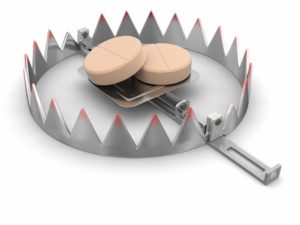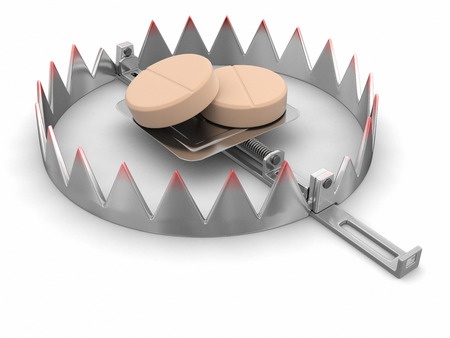
At the end of March in 2016, detectives with the Onondaga County Sheriff’s Office executed a search warrant at a split level home in quiet suburban neighborhood about 8 miles north of Syracuse, New York. They discovered a fentanyl processing operation where six people were mixing and packaging fentanyl for street-level sales. Detectives found an estimated 5,866 doses of fentanyl, 2 ounces of A-PVP (flakka), a loaded 12-gauge shotgun, a replica sub machine gun, drug paraphernalia and $3,571. The total street value of the drugs was $60,000.
The individuals arrested were considerate enough to warn the arresting officers not to touch the fentanyl without gloves. The drug is potent enough to be absorbed through the skin if you touch it without gloves. I guess they were concerned about a possible felony murder charge on top of the drug charges. Although the source of the drug was not known at the time of the drug bust, it typically comes from international sources in Mexico and increasingly from China.
A similar arrest took place near Los Angeles, where four men were operating a pill lab in Baldwin Park. Police found several pill presses and large quantities of variously colored powders, among them acetyl-fentanyl and methamphetamine. DEA Agent David Dowling said: “Fentanyl and its analogues pose a serious public health risk. Even small doses absorbed through the skin or accidentally inhaled can be fatal.” They were getting their drug supply from China. The Southern California lab was just one of four by law enforcement in the U.S. and Canada in March of 2016.
David Armstrong reported for STAT News on both of the above incidents as well as a lab in a custom car business in British Columbia that was shipping 100,000 fentanyl pills monthly to nearby Calgary, Alberta. Police reported that the equipment used to press the pills had come from China. Recently a quarter-ton pill press was intercepted before it was transported to a suburban Los Angeles drug lab. It had been labeled as a “Hole Puncher.”
In an affidavit, DEA agent Lindsey Bellomy said that based on wire transfers and other evidence, she “strongly believes” the Southern California group acquired its fentanyl from China. The affidavit lists a dozen deliveries from China to members of the group in January and February.
The China connection is allowing local drug dealers in North America to mass produce fentanyl in pill form, in some cases producing tablets that look identical to an oft-abused version of the prescription painkiller OxyContin. It also has been added to Xanax pills.
The emergence of decentralized drug labs, using materials obtained from China, makes it difficult to police fentanyl sold as a street drug. A report from the Department of State’s Bureau for International Narcotics and Law Enforcement Affairs indicated China is still a major producer and exporter of fentanyl and other drugs for illicit international markets. Lax regulation, low production costs, and government corruption, mixed in with the country’s large chemical and pharmaceutical industries, makes China a perfect supply source for the materials needed for the illicit drug labs.
Fentanyl pills masquerading as hydrocodone were recently blamed for a wave of overdoses and 11 deaths in the Sacramento California area. The Sacramento Bee reported on April 13, 2016 there had been 51 fentanyl-linked overdoses since late Mach of 2016. By April 27th, the death toll was up to 14. The pills were exact replicas of a medium-strength opioid painkiller, Norco. The CDC discussed this outbreak in detail in one of their Morbidity and Mortality Weekly Reports (MMWR).
Analysis of the fake Norco pulls showed they contained fentanyl, promethazine, acetaminophen and trace amounts of cocaine. Normally used to treat nausea vomiting and motion sickness, promethazine is used here to boost the high of the opioid. Reporting for the Digital Journal, Karn Graham said the pills were exact replicas for the real ones. It was only pure luck that health officials were able to get one of the fake pills from an overdose patient in order to analyze its ingredients. Keri Blakinger, writing for The Fix, said in Canada, British Columbia has declared a public health emergency from the increase of fentanyl overdose deaths in the province.
Lookalike oxycodone pills containing fentanyl have also appeared in Tennessee and Ohio. In testimony before the Committee on Homeland Security and Government Affairs in the U.S. Senate, Carole Rendon, the Acting U.S. Attorney for Northeastern Ohio said the overdose deaths from heroin and fentanyl had risen until they began to see an average of two overdose deaths per day in March of 2016. She said: “Opioid addiction knows no boundaries. It is an equal opportunity killer of old and young, men and women, urban, suburban, and rural, rich and poor, black, white, and Hispanic. We are all at risk.”
In February, Tennessee officials warned about the availability of counterfeit drugs, specifically pills being sold as Percocet that actually contained fentanyl. David Reagan, the Chief Medical Officer of the Tennessee Department of Health said: “When people sell fake pills appearing to be oxycodone but actually containing the more powerful pain medicine fentanyl, lives are at risk.” During a traffic stop in May of 2015 a police officer discovered several 30 mg pills of what appeared to be oxycodone, with its signature A/215 stamp characteristic. Lab analysis showed they were fentanyl. In January of 2016, 300 pills stamped with the characteristic markings for Percocet were found to be fentanyl.
Even worse, counterfeit Xanax pills that contain fentanyl are appearing. In October of 2015 at least three people died from ingesting the combination drug in San Franciso. Saint Petersburg Florida reported that nine people died in Pinellas County from what was being sold as Xanax on the street. The pills were actually a combination of fentanyl and Xanax. The Daily Mail said the combination is sold as “Super Pill” on the street for as little as $5 a pill.
Last, and probably worst, there is another synthetic opioid coming onto the illicit drug market, W-18. It is 100 times more powerful than fentanyl; 10,000 times more powerful than morphine. And again, the likely source for the drug is China. Alan Hudson, an associate professor with the department of pharmacology at the University of Alberta, said W-18 is one of the most dangerous drugs in the whole spectrum of analogs. A tiny speck can cause respiratory failure and kill you.
Global News reported that the drug comes from a “W-series” of opioid compounds first discovered at the University of Alberta in Canada in 1982. Of the 32 compounds, W-1 to W-32, W-18 was the most toxic. As little as four kilograms of the drug is enough to produce millions of tablets. An Edmonton-area drug bust in December 2015 netted four kilograms of W-18.
Because of its potency, W-18 exponentially raises the stakes for potential overdoses. “It’s just too potent to even consider using.” It was never listed as a controlled substance; never tested on humans. So it is technically legal and for sale online—typically from China. “Obviously somebody in China has picked up on the fact that W-18 is quite easy to make in large quantities and they’re trying to sell it to the North American market.”
If you are having trouble understanding why the practices above persist, think about basic branding, marketing and salesmanship. Established brands in the drug market include “heroin” and various pills like: “OxyContin”, “Percocet”, “Xanax”, and even “MDMA.” A significant segment of the drug market has a negative view of heroin, so they prefer to use pharmaceutical versions of opiates/opioids. So they seek out “OxyContin”, “Percocet”, and others. There is also a higher production cost for pills due to their stricter regulation. Pharmaceuticals are legally produced; heroin is not.
Over the past 100 years or so, the government has developed a regulatory process to give consumers some assurance that when they buy pharmaceuticals, they are getting what they paid for. Even with all the problems in the existing regulatory procedures, the modern pharmaceutical consumer is better protected today than they were during the time of patent medicines. THERE IS NO REGULATORY PROCESS FOR ILLICITLY PRODUCED DRUGS.
So if drug dealers and manufacturers want to increase their profits, they produce knockoffs of the more popular drug brands (like Percocet or heroin) by substituting cheaper products for the known brands. Since there is no regulatory process, they can and do sell knockoffs to their customers as the real thing with relative impunity. Illicit drugs today are truly a “buyer beware” market. The consumer/user is risking their health and their life as they seek out the newest, best high.





